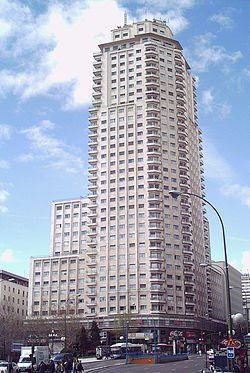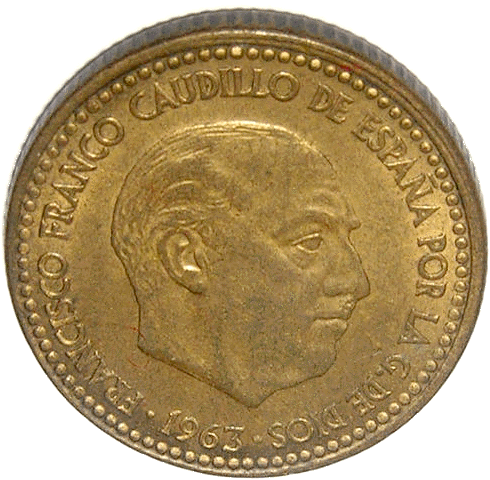
Spanish miracle
Encyclopedia

Spain
Spain , officially the Kingdom of Spain languages]] under the European Charter for Regional or Minority Languages. In each of these, Spain's official name is as follows:;;;;;;), is a country and member state of the European Union located in southwestern Europe on the Iberian Peninsula...
from 1959 to 1974. The international oil
Oil crisis
Oil crisis may refer to:1970s*1970s energy crisis*1973 oil crisis*1979 energy crisisPost 1970s*Oil price increase of 1990*2000s energy crisis...
and stagflation
Stagflation
In economics, stagflation is a situation in which the inflation rate is high and the economic growth rate slows down and unemployment remains steadily high...
crises of the 1970s ended the boom.
The pre-boom situation
The nineteenth century in Spain was marked by political instability and war that continually disrupted economic development, leaving Spain lagging far behind the leading western European countries. The period of the late nineteenth and early twentieth centuries was one of relative stability during which there was considerable economic development. Political instability returned in the 1920s, which was made worse by the Great DepressionGreat Depression
The Great Depression was a severe worldwide economic depression in the decade preceding World War II. The timing of the Great Depression varied across nations, but in most countries it started in about 1929 and lasted until the late 1930s or early 1940s...
, culminating in the devastating Spanish Civil War
Spanish Civil War
The Spanish Civil WarAlso known as The Crusade among Nationalists, the Fourth Carlist War among Carlists, and The Rebellion or Uprising among Republicans. was a major conflict fought in Spain from 17 July 1936 to 1 April 1939...
of 1936 to 1939. The war was won by right wing forces led by Francisco Franco
Francisco Franco
Francisco Franco y Bahamonde was a Spanish general, dictator and head of state of Spain from October 1936 , and de facto regent of the nominally restored Kingdom of Spain from 1947 until his death in November, 1975...
, who was installed as dictator. Cut off from trade by both the western allies and the Communist pact, Franco's regime pursued a policy of autarky
Autarky
Autarky is the quality of being self-sufficient. Usually the term is applied to political states or their economic policies. Autarky exists whenever an entity can survive or continue its activities without external assistance. Autarky is not necessarily economic. For example, a military autarky...
. The economic recovery was slow. Industrial production did not regain its 1936 level until 1955, and the crucial agricultural sector took until 1959 to recover its pre-civil war level. The re-establishment of diplomatic relations with the USA and its allies in the mid 1950s led to an easing in Spain's economic difficulties.
Initiation of the boom
The "economic miracle" was initiated by the reforms promoted by the so-called technocratTechnocracy (bureaucratic)
Technocracy is a form of government where technical experts are in control of decision making in their respective fields. Economists, engineers, scientists, health professionals, and those who have knowledge, expertise or skills would compose the governing body...
s who, with Franco's approval, put in place policies developed in Spain under the guidance of the International Monetary Fund
International Monetary Fund
The International Monetary Fund is an organization of 187 countries, working to foster global monetary cooperation, secure financial stability, facilitate international trade, promote high employment and sustainable economic growth, and reduce poverty around the world...
. The technocrats were a new breed of politicians who replaced the old falangist guard. The implementation of these policies took the form of development
Economic development
Economic development generally refers to the sustained, concerted actions of policymakers and communities that promote the standard of living and economic health of a specific area...
plans and it was largely a success: Spain enjoyed the second highest growth rate in the world, only slightly behind Japan
Japan
Japan is an island nation in East Asia. Located in the Pacific Ocean, it lies to the east of the Sea of Japan, China, North Korea, South Korea and Russia, stretching from the Sea of Okhotsk in the north to the East China Sea and Taiwan in the south...
, and became the ninth largest economy in the world, just after Canada
Canada
Canada is a North American country consisting of ten provinces and three territories. Located in the northern part of the continent, it extends from the Atlantic Ocean in the east to the Pacific Ocean in the west, and northward into the Arctic Ocean...
. Spain joined the industrialized world, leaving behind the poverty and endemic underdevelopment it had experienced following the loss of most of its imperium
Spanish Empire
The Spanish Empire comprised territories and colonies administered directly by Spain in Europe, in America, Africa, Asia and Oceania. It originated during the Age of Exploration and was therefore one of the first global empires. At the time of Habsburgs, Spain reached the peak of its world power....
in the 1820s.
Infrastructure development and tourist destination
The economic expansion was heavily based on public investment in infrastructure developmentand the opening of Spain as a tourist destination. The "miracle" ended the period of autarkyAutarky
Autarky is the quality of being self-sufficient. Usually the term is applied to political states or their economic policies. Autarky exists whenever an entity can survive or continue its activities without external assistance. Autarky is not necessarily economic. For example, a military autarky...
. The economic development brought noticeable improvements in Spanish living standards and the development of a large middle class in Spain. While Spain remained less economically developed relative to the rest of western Europe in the 1970s (excepting Portugal
Portugal
Portugal , officially the Portuguese Republic is a country situated in southwestern Europe on the Iberian Peninsula. Portugal is the westernmost country of Europe, and is bordered by the Atlantic Ocean to the West and South and by Spain to the North and East. The Atlantic archipelagos of the...
, Ireland
Ireland
Ireland is an island to the northwest of continental Europe. It is the third-largest island in Europe and the twentieth-largest island on Earth...
and Greece
Greece
Greece , officially the Hellenic Republic , and historically Hellas or the Republic of Greece in English, is a country in southeastern Europe....
), in the "miracle's" heyday, 1974, Spanish per capita
Per capita
Per capita is a Latin prepositional phrase: per and capita . The phrase thus means "by heads" or "for each head", i.e. per individual or per person...
income had reached 79% of the western European average. The economic indicator par excellence, the production of electricity, had climbed from 3.61 million megawatt-hours in 1940 to 90.82 million megawatt-hours in 1976. Because of the country's limited fossil fuel resources and unreliable hydroelectric potential, the period saw the first stages in establishing a network of nuclear power stations to meet the rapidly growing energy demands.

Rural exodus
The Spanish miracle fed itself on a rural exodusRural exodus
Rural flight is a term used to describe the migratory patterns of peoples from rural areas into urban areas.In modern times, it often occurs in a region following the industrialization of agriculture when fewer people are needed to bring the same amount of agricultural output to market and related...
which created a new class of industrial workers, similar to the French banlieue
Banlieue
In francophone areas, banlieues are the "outskirts" of a city: the zone around a city that is under the city's rule.Banlieues are translated as "suburbs", as these are also residential areas on the outer edge of a city, but the connotations of the term "banlieue" in France can be different from...
or, more recently, the vast migration of China's rural workers into its cities. The economic boom led to an increase in mostly fast, ugly, largely unplanned building on the periphery of the main Spanish cities to accommodate the new workers arriving from the countryside. Some farsighted cities preserved their historic centres, but most were spoilt by haphazard commercial and residential developments. The same fate befell long stretches of scenic coastline as mass tourism exploded.
Mass tourism
Being short of natural resources, the opening up of Spain to mass tourism provided the country with a large source of foreign exchange that was used to pay for the capital imports (machinery, etc) needed for a rapid expansion of infrastructure and industry. This labour intensive industry also provided much employment. Tourism accounted for about ten percent of GDP at its peak in 1970. Another important source of foreign exchange were the many workers who worked in the factories and construction sites of the postwar boom-time countries of Europe, especially Germany, Switzerland and France.Domestic market
The expansion reinvigorated old industrial areas: the Basque countryBasque Country (autonomous community)
The Basque Country is an autonomous community of northern Spain. It includes the Basque provinces of Álava, Biscay and Gipuzkoa, also called Historical Territories....
and Ferrol northern coast (iron and steel, shipbuilding), in and around Barcelona (machinery, textiles, chemicals) it also drove an enormous expansion in refining, petrochemicals, chemicals and engineering, and saw the emergence of the Madrid region as a major industrial and commercial zone. In well under twenty years, from being a largely rural country with just a few enclaves of dated industry and an antiquated agricultural sector, slowly recovering from war, Spain had developed a major industrial economy producing most items, ranging from shoes to aircraft. Most of this production supplied the domestic market which was heavily protected from international competition. Even after considerable liberalisation, the government still exercised much direct control of the economy, including the ownership of a number of important enterprises.
Automotive industry
The automotive industry was one of the most powerful locomotives of the Spanish Miracle: from 1958 to 1972 it grew at a yearly compound rate of 21.7%; in 1946 there were 72,000 private cars in Spain, in 1966 there were 1 million. This growth rate had no equal in the world.The icon
Icon
An icon is a religious work of art, most commonly a painting, from Eastern Christianity and in certain Eastern Catholic churches...
of the Desarrollo was the SEAT 600
SEAT 600
The SEAT 600 was a Spanish car made by SEAT from May 1957 to August 1973. It helped to start the economic boom, the Spanish Miracle , that came at the end of the slow recovery from the Spanish Civil War...
car, produced by the Spanish company SEAT
SEAT
SEAT, S.A. is a Spanish automobile manufacturer founded on May 9, 1950 by the Instituto Nacional de Industria , a state-owned industrial holding company....
. More than 794,000 of them were made between 1957 and 1973, and if at the beginning of this period it was the first car for many Spanish working class families, at its end it was the first second one for many more.
See also
- Economic miracleEconomic miracleThe terms "economic miracle", "economic boom", "tiger economy" or simply "miracle" have come to refer to great periods of change, particularly periods of dramatic economic growth, in the recent histories of a number of countries:-Post-World War II:...
- German WirtschaftswunderWirtschaftswunderThe term describes the rapid reconstruction and development of the economies of West Germany and Austria after World War II . The expression was used by The Times in 1950...
("German economic miracle") - Instituto Nacional de IndustriaInstituto Nacional de Industria'Instituto Nacional de Industria' , literally National Institute of Industry, was a Spanish state-owned financing and industrial holding company, currently succeeded by the Sociedad Estatal de Participaciones Industriales' .-History:...
- PegasoPegasoPegaso was a Spanish make of trucks, omnibuses, tractors, armored vehicles, and, for a while, sports cars. The parent company, Enasa, was created in 1946 and based in the old Hispano-Suiza factory, under the direction of the renowned automotive engineer Wifredo Ricart...
- SEATSEATSEAT, S.A. is a Spanish automobile manufacturer founded on May 9, 1950 by the Instituto Nacional de Industria , a state-owned industrial holding company....
- Spain under Franco

